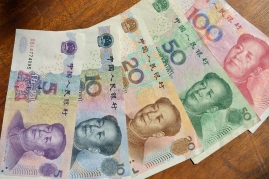Trade Forex with the Chinese Yuan

The symbol used for the Yuan is ¥, and there are three Forex codes connected with this currency: RMB, CNY and CNH (which refers to the offshore tradable currency). The Chinese Yuan is used across the People’s Republic of China but not in Macau or Hong Kong (although it is sometimes accepted in these two regions), and it is not accepted as legal tender in Taiwan. There are several other nations that welcome trade in the Chinese Yuan, including Laos, Cambodia, North Korea, Mongolia and Nepal, as well as Myanmar.
The rate of the CNY is set by the central bank, the People’s Bank of China, and it has a narrow band of variation, basing its value against several international currencies. The Yuan was originally pegged to the US Dollar, and this has been the case off and on over the last few years, with the most recent de-pegging occurring in 2010. Although before 2009 there was very little international trading in the CNY because of the policies put in place by the Chinese government, since that time it has been possible to make direct transactions in the Yuan, and trade agreements have been made between China and Thailand, Russia, Japan and Vietnam to settle trade transactions in the Yuan without the need to convert the currency into US Dollars first. The Yuan trades within a 0.5% variation band from the rate set by the Central Bank, and its price is based against a number of international currencies including those of Singapore, Canada, Australia, Russia, Thailand, the UK, South Korea, Japan, the Euro, and primarily the US Dollar.
| Broker | Bonus | More |
|---|
The History of the Chinese Yuan
When the Communist Party took power in China it began to issue a currency of its own, which replaced the several forms of currency that existed across all of the many areas it controlled. The first issuance of the unified currency occurred in 1948, and by 1949, the currency was named the Renminbi. For much of its history, the Yuan has been pegged to the US Dollar as well as several other western currencies. However, since the 1980s there has been an ongoing attempt to set the rate of the currency at a more realistic level in order to make it more convertible.
In recent times, due to the move of the country towards a market economy, the Yuan has been devalued to increase the nation’s ability to compete in the export markets. In 2005, the CNY was de-pegged from the US Dollar but was then re-pegged to it during 2008 to 2010 owing to an international financial crisis. It is hoped by the Chinese government that the Yuan will eventually be established as a South-East Asian regional currency with the strength to compete with the Euro or Japanese Yen, and they are moving towards the establishment of the Yuan as one of the major reserve currencies.
A Guide to the Chinese Economy
The socialist market economy of China is the second largest in the world when measured by nominal GDP, and the biggest global economy in terms of its PPP. Up until 2015, the economy of China was the fastest-growing in the world, averaging a rate of growth of 10% over 30 years. Although China’s private sector is currently burgeoning, its public sector is responsible for a much larger share of the national economy due to the political and historical realities of the country’s economy.
China’s economy is heavily based on manufacturing, and indeed the country has the biggest worldwide manufacturing economy, being the world’s biggest goods exporter. As well as being a global manufacturing hub, China also has the fastest-growing consumer market in the world, being the second biggest importer worldwide.
China has a key role to play in international trade, being the world’s largest trading nation. It has been a member of the World Trade Organisation since 2001, and the country has also forged free-trading agreements with a number of countries including Pakistan, Switzerland, New Zealand, South Korea and Australia.
Although the coastal regions of China are quite industrialised, in the hinterland the regions show less industrial development. Agricultural products are also essential to the Chinese economy, with over 300 million of the population being employed in this industry. China is the world’s major producer of rice, and is also one of the world’s principal sources of corn, wheat, tobacco, peanuts, fish, soy beans, potatoes, pork and other non-food crops such as cotton and oil seeds.


